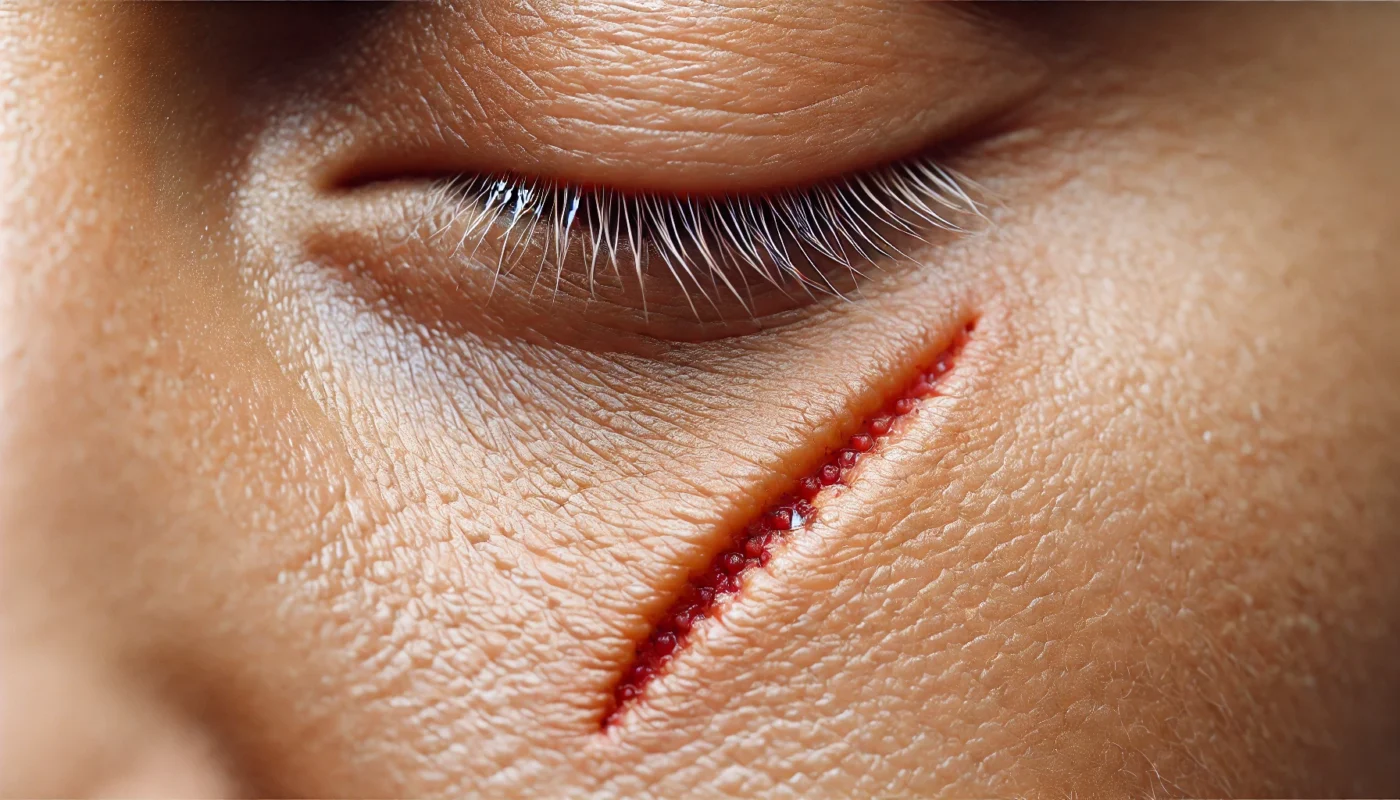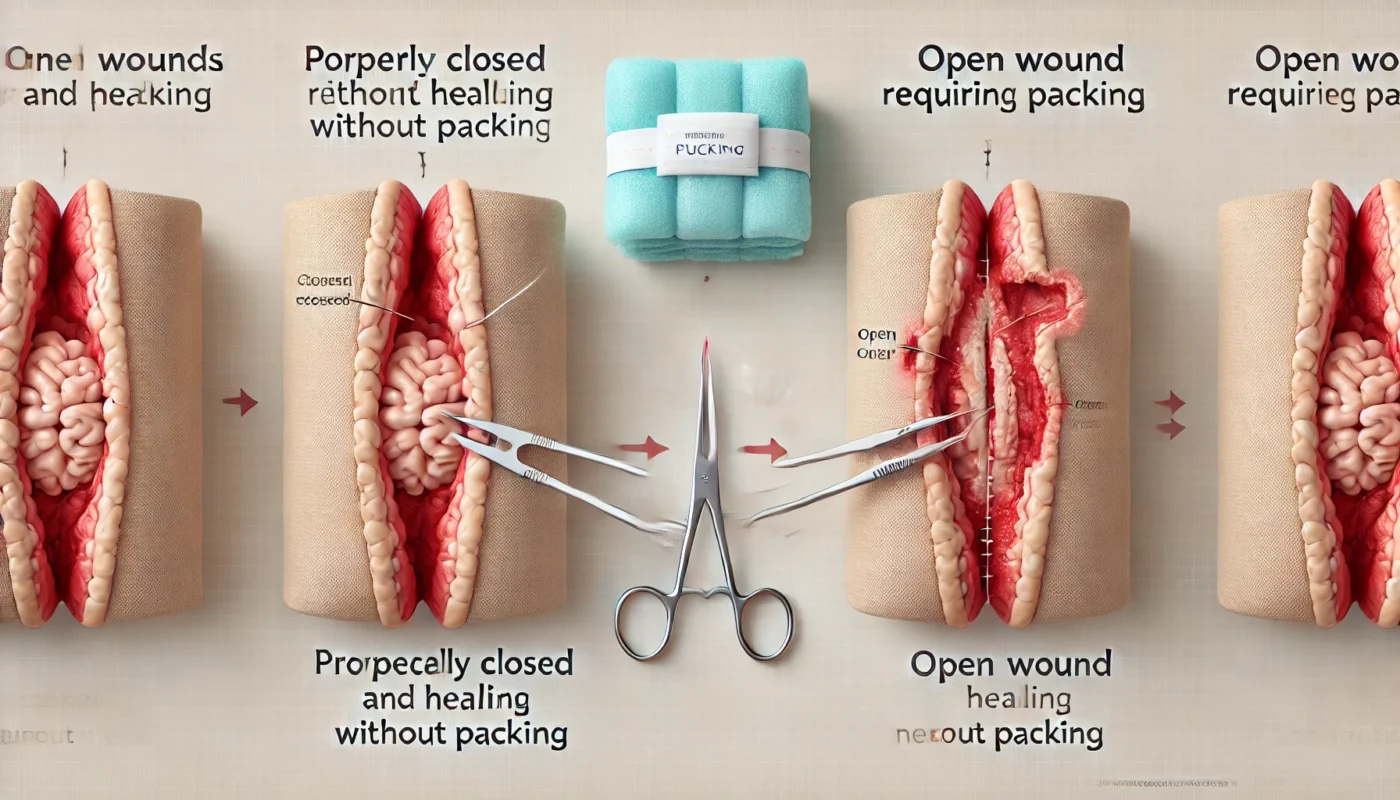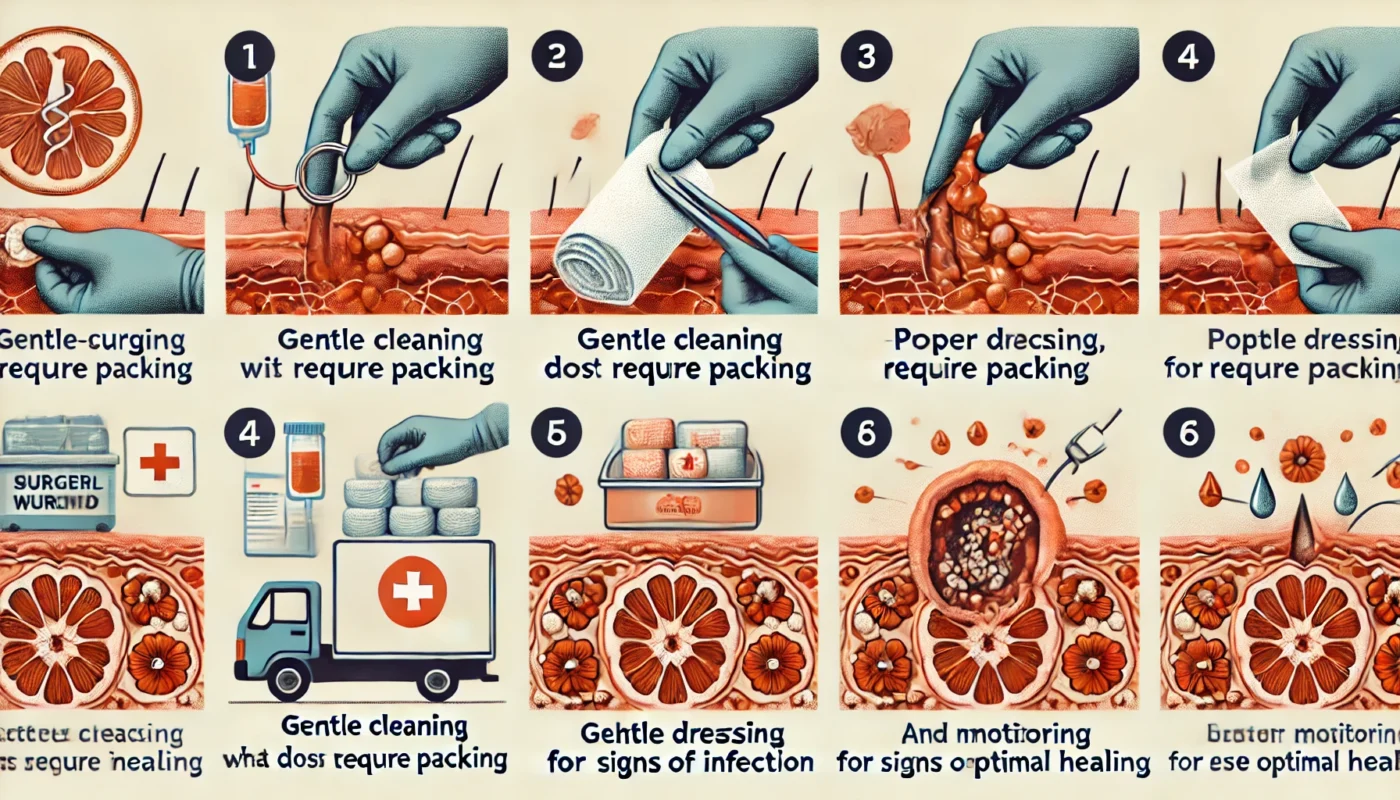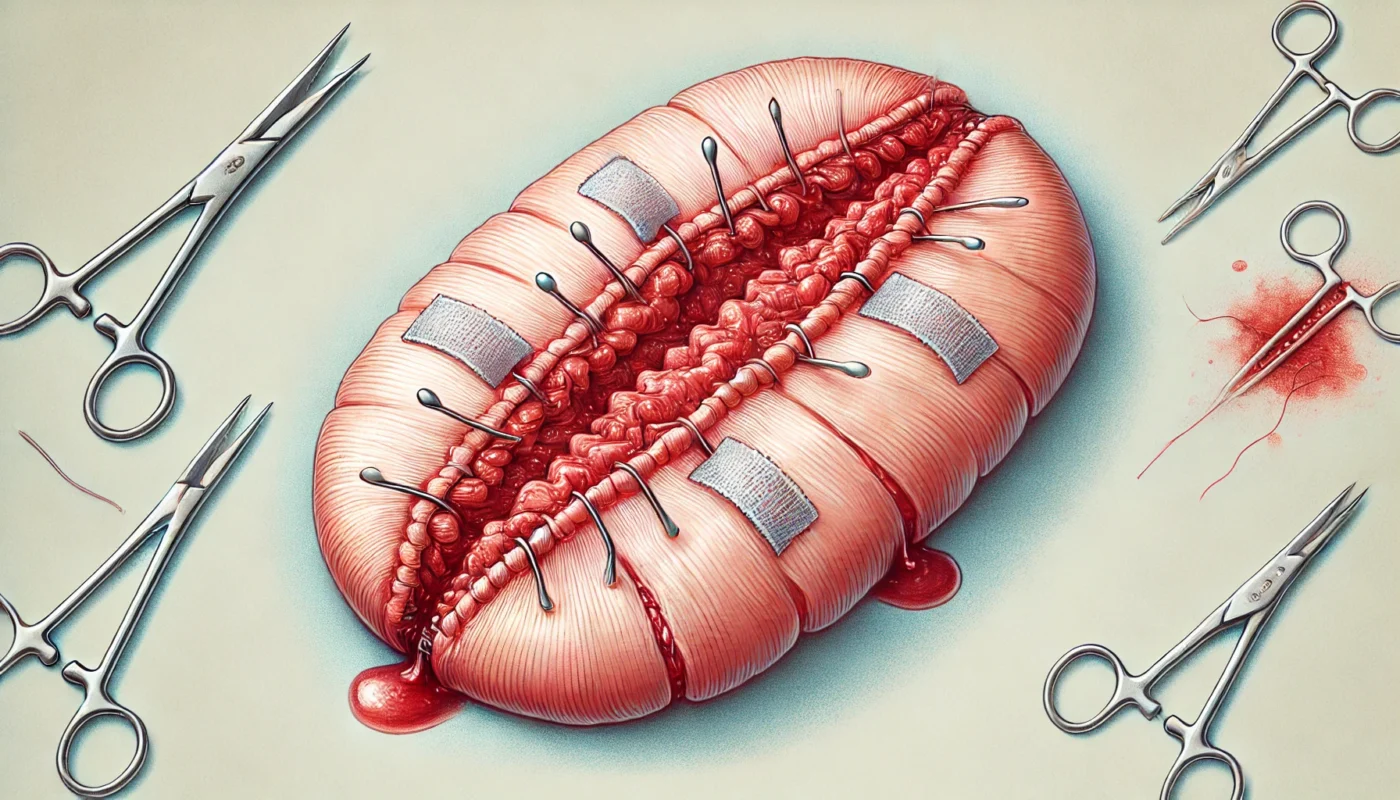Wound packing is a method used in wound care to fill the space within a wound, particularly those that are deep or have a significant cavity. This process helps in absorbing drainage, keeping the wound clean, and promoting healing from the inside out. It’s a technique often used in surgical wounds to prevent the accumulation of fluids and to minimize the risk of infection.
You may also like: Key Factors in Proliferative Wound Healing
Importance of Moisture Balance
The balance of moisture is a crucial aspect of wound healing. Packing helps maintain this moisture by providing a controlled environment that supports the healing process. Too little moisture can lead to desiccation and cell death, while too much can cause maceration and slow healing. Properly packed wounds strike this balance, facilitating cell migration and the formation of new tissue.
Types of Packing Materials
Various packing materials are available, each suited to different wound types and conditions. Gauze is commonly used due to its absorbent properties, but newer materials like alginates, foams, and hydrogels offer advanced benefits. These materials can provide more tailored moisture control and antibacterial properties, enhancing the healing environment.
Risks of Improper Packing
Improper packing can lead to complications such as infection, delayed healing, or damage to surrounding tissue. Overpacking can exert pressure on the wound bed, restricting blood flow and impeding healing. Conversely, underpacking may fail to absorb adequate drainage, increasing the risk of infection. Understanding how to pack correctly is vital for optimal healing.
The Role of Packing in Healing
Packing is not always necessary for all wounds, but it plays a vital role in specific circumstances. Its primary function is to provide a moist environment conducive to healing, which is essential for granulation tissue to form. This tissue is the new connective tissue and microscopic blood vessels that form on the surfaces of a wound during the healing process.
Promoting Granulation Tissue
Granulation tissue is the foundation of wound healing, filling in the wound space and providing a matrix for new cells to grow. Packing supports the development of this tissue by maintaining a moist environment and preventing the wound edges from closing prematurely. This ensures the wound heals from the bottom up, reducing the risk of abscess formation.
Preventing Infection
A well-packed wound minimizes the risk of infection by absorbing exudate and keeping the wound clean. The packing material acts as a barrier to bacteria and other contaminants, reducing the likelihood of infection. Regular changing of the packing material is crucial to maintain cleanliness and promote healing.
Supporting Autolytic Debridement
Packing can facilitate autolytic debridement, a natural process where the body’s enzymes break down dead tissue. This is crucial for wound healing as it removes barriers to new tissue growth. The moist environment provided by packing materials supports this process, allowing for more effective and efficient wound healing.

When to Stop Packing a Surgical Wound
Recognizing when to discontinue packing is crucial to avoid hindering the healing process. Overpacking can lead to unnecessary irritation and may slow down the healing. Here are some signs that indicate your surgical wound may not need packing anymore:
Reduced Drainage
One of the primary indicators that a wound no longer requires packing is a significant decrease in drainage. If you notice that the amount of fluid or exudate is minimal, it may be time to consult your healthcare provider about discontinuing packing.
Monitoring Drainage Levels
Consistently monitor the level of drainage from the wound. Keeping a log of the quantity and quality of exudate can provide valuable insights into the healing progress. A reduction in drainage suggests that the wound is closing and healing effectively, signaling that packing may not be necessary.
Types of Drainage
Understanding the type of drainage is also essential. Serous drainage, which is clear and watery, is normal, whereas purulent drainage, which is thick and yellowish, may indicate infection. If the drainage is clear and minimal, it is a positive sign that the wound is healing well.
Consulting Healthcare Professionals
Always consult with healthcare professionals before making changes to your wound care regimen. They can provide guidance based on their assessment of the wound’s healing stage and drainage levels, ensuring that you make informed decisions about discontinuing packing.
Granulation Tissue Formation
The presence of healthy granulation tissue is a positive sign that your wound is healing well. This tissue appears as a pinkish or reddish granular layer and indicates that the wound is filling in from the bottom up. Once this tissue has adequately formed, packing may no longer be necessary.
Characteristics of Healthy Granulation
Healthy granulation tissue is firm, moist, and has a rough texture. Its bright red color indicates good blood flow, which is essential for healing. Monitoring the appearance of this tissue is vital to determine the need for continued packing.
Progression of Granulation
Granulation progresses from the edges of the wound inward, gradually filling the wound cavity. As this tissue develops, the need for packing diminishes. Observing this progression helps in assessing when packing is no longer necessary.
Encouraging Granulation
Certain practices can encourage the formation of granulation tissue. Ensuring a balanced diet, proper hydration, and avoiding smoking can significantly impact the quality and speed of granulation. These factors contribute to an optimal healing environment.
Decreased Wound Depth
As a wound heals, its depth decreases. Regular assessments by a healthcare provider can measure this change. When the wound is shallow enough that it no longer requires the support of packing material, it’s a sign that packing may be discontinued.
Measuring Wound Depth
Healthcare providers use specific tools to measure wound depth accurately. These assessments are crucial for tracking healing progress and determining when packing is no longer needed. Consistent measurements provide a clear picture of how the wound is closing.
Factors Affecting Wound Depth
Various factors can affect how quickly a wound’s depth decreases, including the patient’s overall health, nutrition, and compliance with care instructions. Understanding these factors can help set realistic expectations for healing.
Transitioning from Packing
As the wound depth decreases, the transition away from packing should be gradual. Healthcare providers may suggest alternative dressings that continue to support healing without the need for packing materials.

Surgical Wound Care: Best Practices
Even when packing is no longer needed, proper wound care remains essential to ensure complete healing and to prevent complications. Here are some best practices for surgical wound care:
Keep the Wound Clean and Dry
Maintaining cleanliness is paramount in wound care. Regularly clean the wound with mild soap and water, and gently pat it dry. Avoid using alcohol or hydrogen peroxide, as these can damage healthy tissue.
Daily Cleaning Routine
Establish a daily routine for cleaning your wound. Consistency is key to preventing infection and promoting healing. Use gentle motions to clean the wound, ensuring that you do not disrupt any new tissue that is forming.
Products to Avoid
Certain products can hinder healing. Avoid using harsh chemicals or abrasive materials on your wound. Stick to gentle, pH-balanced soaps and clean water to maintain a healthy healing environment.
Importance of Dryness
After cleaning, ensure the wound is thoroughly dried. Moisture can lead to infection if left unchecked. Pat the wound dry with a clean towel, rather than rubbing, to prevent irritation.
Use Appropriate Dressings
Even without packing, dressings protect the wound from infection and promote healing. Choose dressings that maintain a moist environment, such as hydrocolloids or hydrogels, which can support the healing process.
Types of Dressings
Different types of dressings serve various purposes. Hydrocolloid dressings provide a moist environment conducive to healing, while alginates are excellent for wounds with higher exudate levels. Selecting the appropriate dressing is crucial for optimal healing.
Changing Dressings
Regularly change dressings to maintain cleanliness and effectiveness. Follow healthcare provider instructions on how often to change your dressing, as this varies depending on the wound type and healing stage.
Benefits of Moist Dressings
Moist dressings support autolytic debridement and cell migration, critical components of the healing process. They provide a barrier to bacteria while allowing the wound to breathe, facilitating a balanced healing environment.
Monitor for Signs of Infection
Stay vigilant for signs of infection, which can include increased redness, swelling, warmth, or pus-like drainage. If you observe any of these symptoms, contact your healthcare provider promptly.
Common Infection Indicators
Familiarize yourself with common infection indicators to catch issues early. Symptoms like fever, increased pain, or foul-smelling drainage require immediate attention and can prevent complications if addressed quickly.
Preventive Measures
Prevent infection by following strict hygiene practices. Wash your hands before touching the wound, and use sterile equipment when changing dressings. These simple measures can significantly reduce infection risk.
Seeking Professional Help
Do not hesitate to seek professional help if you suspect an infection. Early intervention can prevent serious complications and promote faster healing. Your healthcare provider can prescribe antibiotics or other treatments as needed.
Follow-Up with Healthcare Providers
Regular check-ins with your healthcare provider are crucial to monitor the progress of your wound healing. They can provide guidance on when to adjust your wound care routine or when to stop certain treatments, like packing.
Scheduled Appointments
Keep scheduled appointments with your healthcare provider to assess wound healing. These visits allow for professional evaluation and adjustment of care plans based on the wound’s progress.
Communication with Providers
Maintain open communication with your healthcare provider about any changes or concerns with your wound. Providing detailed information helps them make informed decisions about your care.
Adjusting Care Plans
As the wound heals, care plans may need adjustments. Providers can recommend changes to dressing types, cleaning routines, or other aspects of wound care, ensuring that the healing process continues smoothly.

Holistic Approaches to Wound Healing
In addition to traditional wound care practices, integrating holistic approaches can support the healing process. These methods focus on the body as a whole and can complement medical treatments.
Nutrition and Hydration
A balanced diet rich in vitamins, minerals, and proteins is essential for wound healing. Nutrients like vitamin C, zinc, and protein play a crucial role in tissue repair. Staying hydrated is also vital to support cellular functions and recovery.
Essential Nutrients
Vitamins A and C, zinc, and proteins are vital for collagen synthesis and tissue repair. Incorporating foods rich in these nutrients, such as citrus fruits, lean meats, and legumes, can enhance the healing process.
Hydration Tips
Staying hydrated ensures that cells function optimally. Aim to drink at least 8-10 glasses of water a day, adjusting for factors like activity level and climate. Proper hydration supports nutrient transport and waste elimination.
Dietary Adjustments
Consider making dietary adjustments to include more healing-promoting foods. Foods high in antioxidants, such as berries and leafy greens, can combat inflammation and support wound recovery.
Stress Management
Stress can negatively impact the healing process by weakening the immune system. Practices such as meditation, yoga, or deep-breathing exercises can help manage stress levels and promote a conducive healing environment.
Impact of Stress on Healing
Chronic stress can slow wound healing by affecting hormone levels and immune function. Understanding this impact underscores the importance of effective stress management in recovery.
Relaxation Techniques
Incorporate relaxation techniques into your daily routine. Simple practices like deep breathing, progressive muscle relaxation, or guided imagery can reduce stress and support the healing process.
Creating a Healing Environment
Create a calming environment that supports relaxation. Soft lighting, soothing music, and aromatherapy can enhance your space, making it more conducive to healing and reducing stress levels.
Herbal Remedies
Certain herbs and supplements are known for their healing properties. Aloe vera, honey, and calendula have been traditionally used to promote wound healing. However, always consult with a healthcare professional before using any herbal remedies to ensure they are safe and appropriate for your specific condition.
Benefits of Aloe Vera
Aloe vera is known for its soothing and anti-inflammatory properties. It can be applied topically to support skin repair and reduce irritation, making it a popular choice for wound care.
Healing Properties of Honey
Honey has natural antibacterial properties and can create a moist healing environment. Medical-grade honey can be used under professional guidance to enhance wound healing.
Calendula’s Role in Healing
Calendula has been used traditionally to reduce inflammation and promote healing. Its extracts can be found in various topical preparations, offering a natural option for wound care support.
Conclusion
Recognizing when a surgical wound no longer needs packing is an important aspect of wound care that can enhance healing and prevent complications. By observing the signs of reduced drainage, granulation tissue formation, and decreased wound depth, you can make informed decisions about your wound management.
Incorporating holistic approaches alongside traditional methods can further support your recovery journey. Always consult with healthcare professionals to tailor your wound care plan to your specific needs, ensuring a smooth and efficient healing process. Your proactive approach to wound care will significantly contribute to your overall wellbeing and recovery.
Through a comprehensive understanding of wound care practices and the integration of holistic strategies, you empower yourself to manage your healing journey effectively. Balancing traditional and alternative methods provides a robust framework for optimal recovery, fostering a healthier and more resilient you.
Further Reading:
Surgical wound infection – treatment
infection, wound care, healing, hygiene, nutrition, hydration, stress management, herbal remedies, healthcare, preventive measures, holistic approaches, essential nutrients, communication, follow-up, relaxation techniques, aloe vera, honey, calendula
Important Note: The information contained in this article is for general informational purposes only, and should not be construed as health or medical advice, nor is it intended to diagnose, prevent, treat, or cure any disease or health condition. Before embarking on any diet, fitness regimen, or program of nutritional supplementation, it is advisable to consult your healthcare professional in order to determine its safety and probable efficacy in terms of your individual state of health.
Regarding Nutritional Supplements Or Other Non-Prescription Health Products: If any nutritional supplements or other non-prescription health products are mentioned in the foregoing article, any claims or statements made about them have not been evaluated by the U.S. Food and Drug Administration, and such nutritional supplements or other health products are not intended to diagnose, treat, cure, or prevent any disease.

